Fingolimod hydrochloride
Synonym(s):2-Amino-2-[2-(4-octyl-phenyl)-ethyl]-propane-1,3-diol hydrochloride;Fingolimod hydrochloride;FTY720
- CAS NO.:162359-56-0
- Empirical Formula: C19H34ClNO2
- Molecular Weight: 343.93
- MDL number: MFCD00939512
- EINECS: 680-631-1
- SAFETY DATA SHEET (SDS)
- Update Date: 2024-12-12 15:32:36
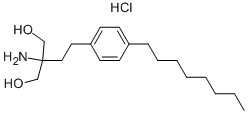
What is Fingolimod hydrochloride?
Description
Approved by the U.S. FDA in September 2010, fingolimod (also referred to as FTY720) is the first approved oral therapy for the relapsing-remitting form ofmultiple sclerosis (RRMS). Because of fingolimod’s structural resemblance to sphingosine, a metabolite of sphingolipids that constitutes the cell membrane of all eukaryotic cells, it was hypothesized that fingolimod may be affecting sphingolipid metabolism in cells. A series of elegant in vitro and in vivo studies confirmed that fingolimod is converted to (S)-fingolimod phosphate primarily by sphingosine kinase- 2 and that (S)-fingolimod phosphate mediates multiple biological processes by binding to novel GPCR’s referred to as sphingosine-1-phosphate (S1P) receptors. S1P receptors are divided into five subtypes, S1P1–5, which have varying tissue and cellular distribution. S1P1–3 receptors are ubiquitously expressed in the immune, cardiovascular, and central nervous systems, S1P4 is restricted to the hematopoietic system, and S1P5 is mostly localized in the white matter of CNS. S1P1–3 receptors play important roles in endothelial barrier function, maintaining vascular tone, regulating heart rate and allowing for lymphocyte egress fromsecondary lymphoid organs. The functional role of S1P4 is unknown,while the S1P5 receptor is thought to be involved in natural killer cell trafficking and oligodendrocyte function.
Chemical properties
White Solid
Originator
Yoshitomi Pharmaceutical Industries (now Mitsubishi Tanabe Pharma) (United States)
The Uses of Fingolimod hydrochloride
Fingolimod Hydrochloride is a derivative of ISP-1 (myriocin), a fungal metabolite of the Chinese herb Iscaria sinclarii as well as a structural analogue of Sphingosine. Fingolimod is a novel immune modulator that prolongs allograft transplant survival in numerous models by inhibiting lymphocyte emigration from lymphoid organs. Fingolimod is reported to be phosphorylated by sphingosine kinase to FTY720-P, which has been shown to potently stimulate GTPgS binding activity in S1P-transfected CHO cells (EC50 = 210 pM, 4.9 nM, 4.3 nM, and 1 nM for S1P1, S1P3, S1P4 and S1P5, respectively).
The Uses of Fingolimod hydrochloride
A derivative of ISP-1 (myriocin), a fungal metabolite of the Chinese herb Iscaria sinclarii as well as a structural analogue of Sphingosine. It is a novel immune modulator that prolongs allograft transplant survival in numberour models by inhibitin
The Uses of Fingolimod hydrochloride
Oral medicine for the treatment of multiple sclerosis
The Uses of Fingolimod hydrochloride
FTY720 is a derivative of ISP-1 (myriocin), a fungal metabolite of the Chinese herb Iscaria sinclarii as well as a structural analogue of Sphingosine. FTY720 is a novel immune modulator that prolong s allograft transplant survival in numberour models by inhibiting lymphocyte emigration from lymphoid organs. FTY720 us reported to be phosphorylated by sphingosine kinase to FTY720-P, which has been shown to potently stimulate GTPgS binding activity in S1P-transfected CHO cells (EC50 = 210 pM, 4.9 nM, 4.3 nM, and 1 nM for S1P1, S1P3, S1P4 and S1P5, respectively).
The Uses of Fingolimod hydrochloride
A cell-permeable aminopropanediol immunosuppressive agent that displays lymphocyte sequestration properties.
What are the applications of Application
FTY720 is a cell-permeable immunosuppressive agent
Definition
ChEBI: The hydrochloride salt of 2-amino-2-[2-(4-octylphenyl) ethyl]-1,3-propanediol (fingolimod).
brand name
Gilenya
Biochem/physiol Actions
FTY720 is an immunomodulating drug and sphingosine 1-phosphate (S1P) receptor modulator. Phosphorylation of FTY270 by sphingosine kinase causes S1P1R internalization, which sequesters lymphocytes in lymph nodes, preventing them from taking part in an autoimmune response. Clinically, it has been approved for the treatment of multiple sclerosis (MS). It has also been shown to block and reverse paclitaxel-induced chemotherapy induced peripheral neuropathy (CIPN) through S1PR inhibition as well as inhibit the activity of histone deacetylases in the hippocampus of mouse brains, thereby modulating memory.
Clinical Use
Fingolimod hydrochloride is an immunosuppressive drug developed by Novartis and approved in the U.S., Europe, and Australia in 2010 for the treatment of multiple sclerosis. The structure of fingolimod derives from the naturally-occurring myriocin (ISP-1) metabolite of the fungus I. sinclairii and the aminoalcohol functionality within the drug possesses structural similarity to the sphingosine family of natural products.
Synthesis
Although several convenient preparations of fingolimod (FTY720) have been reported in the literature, the route most closely resembling the process-scale approach is described in the scheme. Friedel-Crafts acylation of commercial toluene derivative 89 with bromoacetyl chloride followed by ethoxide-mediated N-acylated aminomalonate (91) attack onto the resulting -bromoketone 90 gave rise to ketoamide 92 in good overall yield. Next, separate hydride reduction protocols were employed to furnish diol 93. Presumably, triethylsilyl hydride reduced the ketone and both ethyl esters within 92 to the corresponding diacid, which then underwent lithium aluminum hydride treatment to arrive at diol 93. Careful attention to stoichiometry was required to avoid over reduction of amide 93, which was critical to achieve high-yielding (76%) salt formation of fingolimod HCl (VI) through the use of 6 N ethanolic hydrochloric acid.
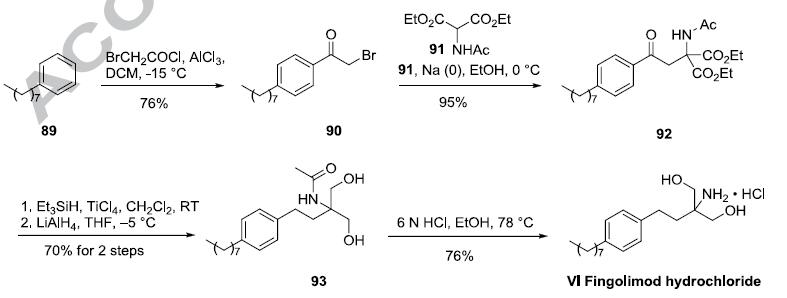
storage
+4°C
References
1) Brinkmann et al. (2002), The immune modulator FTY720 targets spingosine-1-phosphate receptors; J. Biol. Chem., 277 21453 2) Wolf et al. (2009), The sphingosine 1-phosphate receptor agonist FTY720 potently inhibits regulatory T cell proliferation in vitro and in vivo; J. Immunol., 183 3751 3) Awojoodu et al. (2013), Sphingosine 1-phosphate receptor 3 regulates recruitment of anti-inflammatory monocytes to microvessels during implant arteriogenesis; Proc. Natl. Acad. Sci. USA, 110 13785 4) Chiba (2005), FTY720, a new class of immunomodulator, inhibits lymphocyte egress from secondary lymphoid tissues and thymus by agonistic activity at sphingosine 1-phosphate receptors; Pharmacol. Ther., 108 308
Properties of Fingolimod hydrochloride
| Melting point: | 102-107°C |
| storage temp. | -20°C |
| solubility | water: soluble10mg/mL, clear |
| form | powder |
| color | white to beige |
| Merck | 14,4083 |
| Stability: | Stable for 1 year from date of purchase as supplied. Solutions in DMSO or ethanol may be stored at -20° for up to 3 months. |
| CAS DataBase Reference | 162359-56-0(CAS DataBase Reference) |
Safety information for Fingolimod hydrochloride
| Signal word | Warning |
| Pictogram(s) |
 Health Hazard GHS08 |
| GHS Hazard Statements |
H373:Specific target organ toxicity, repeated exposure |
| Precautionary Statement Codes |
P260:Do not breathe dust/fume/gas/mist/vapours/spray. P314:Get medical advice/attention if you feel unwell. P501:Dispose of contents/container to..… |
Computed Descriptors for Fingolimod hydrochloride
| InChIKey | SWZTYAVBMYWFGS-UHFFFAOYSA-N |
Fingolimod hydrochloride manufacturer
Alembic Pharmaceuticals Limited
Shilpa Medicare Limited (SML)
Opulant Pharmaceuticals Pvt Ltd
Ascott Pharma
Shivalik Rasayan Ltd
New Products
(S)-3-Aminobutanenitrile hydrochloride 4-Methylphenylacetic acid N-Boc-D-alaninol N-BOC-D/L-ALANINOL Tert-butyl bis(2-chloroethyl)carbamate N-octanoyl benzotriazole 3-Morpholino-1-(4-nitrophenyl)-5,6-dihydropyridin- 2(1H)-one Furan-2,5-Dicarboxylic Acid S-2-CHLORO PROPIONIC ACID ETHYL ISOCYANOACETATE 2-Bromo-1,3-Bis(Dimethylamino)Trimethinium Hexafluorophosphate 4-IODO BENZOIC ACID 3-NITRO-2-METHYL ANILINE 1-(2,4-DICHLOROPHENYL) ETHANAMINE (2-Hydroxyphenyl)acetonitrile 4-Bromopyrazole 5,6-Dimethoxyindanone 2-(Cyanocyclohexyl)acetic acid 4-methoxy-3,5-dinitropyridine 1-(4-(aminomethyl)benzyl)urea hydrochloride 2-aminopropyl benzoate hydrochloride diethyl 2-(2-((tertbutoxycarbonyl)amino) ethyl)malonate tert-butyl 4- (ureidomethyl)benzylcarbamate Ethyl-2-chloro((4-methoxyphenyl)hydrazono)acetateRelated products of tetrahydrofuran

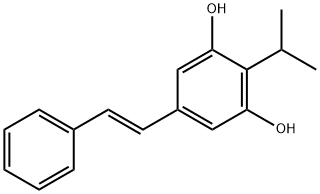

![N-[1,1-Bis[(acetyloxy)methyl]-3-(4-octylphenyl)propyl]acetamide](https://img.chemicalbook.in/CAS/GIF/162358-09-0.gif)

![2-(Acetylamino)-2-[2-(4-octylphenyl)-2-oxoethyl]-propanedioic acid 1,3-diethyl ester](https://img.chemicalbook.in/CAS/20150408/GIF/268557-49-9.gif)


You may like
-
 162359-56-0 Fingolimod Hydrochloride 98%View Details
162359-56-0 Fingolimod Hydrochloride 98%View Details
162359-56-0 -
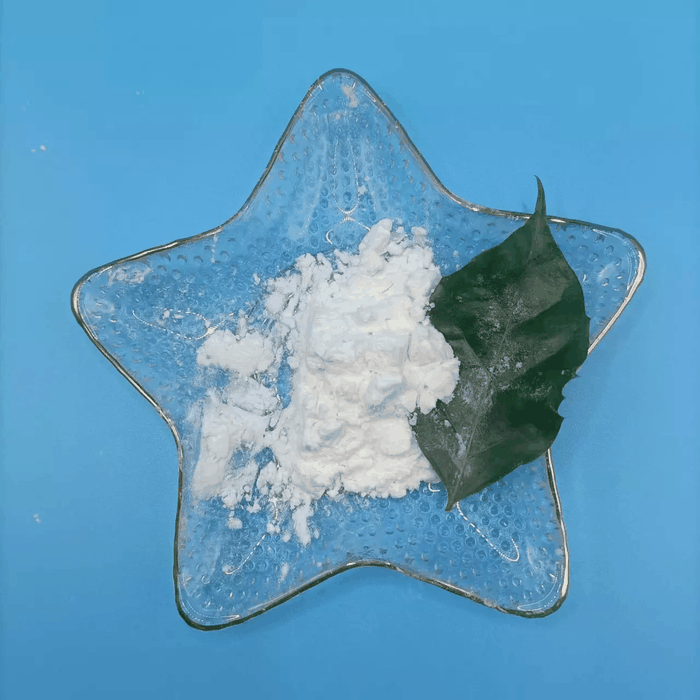 Fingolimod.HCl 98%View Details
Fingolimod.HCl 98%View Details
162359-56-0 -
 Fingolimod HCl 98% (HPLC) CAS 162359-56-0View Details
Fingolimod HCl 98% (HPLC) CAS 162359-56-0View Details
162359-56-0 -
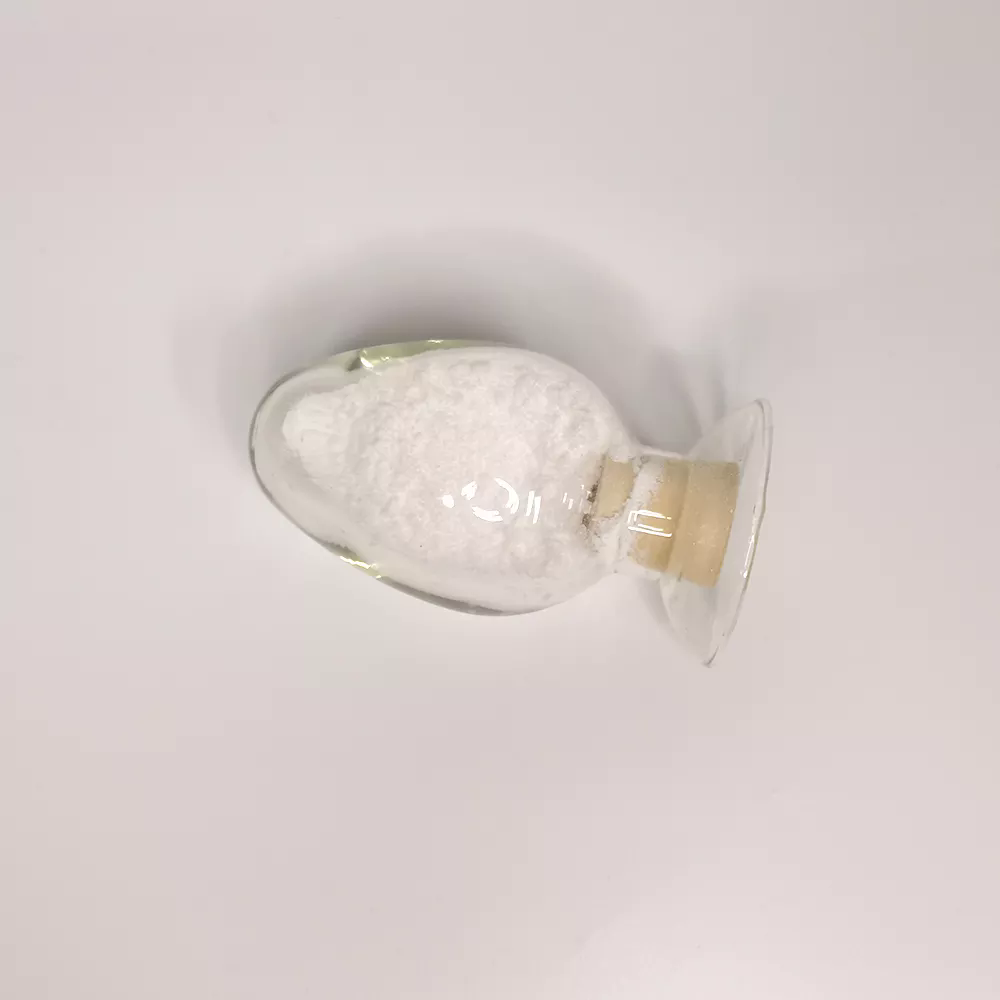 162359-56-0 Fingolimod hydrochloride 98%View Details
162359-56-0 Fingolimod hydrochloride 98%View Details
162359-56-0 -
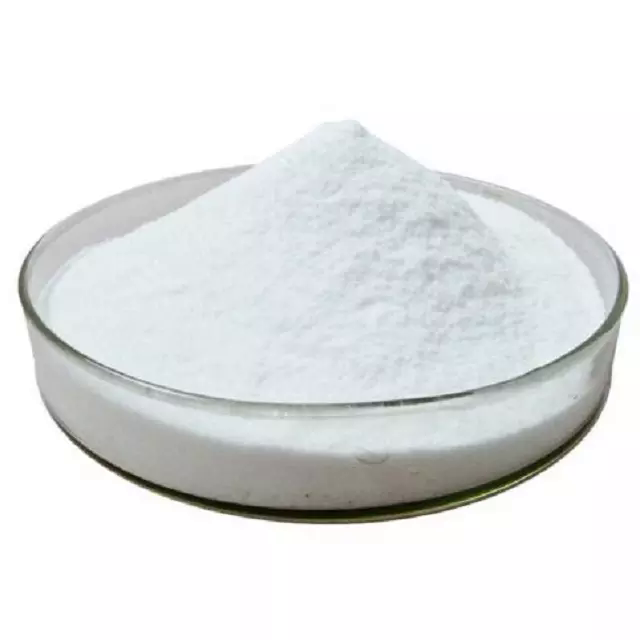 162359-56-0 Fingolimod hydrochloride 98%View Details
162359-56-0 Fingolimod hydrochloride 98%View Details
162359-56-0 -
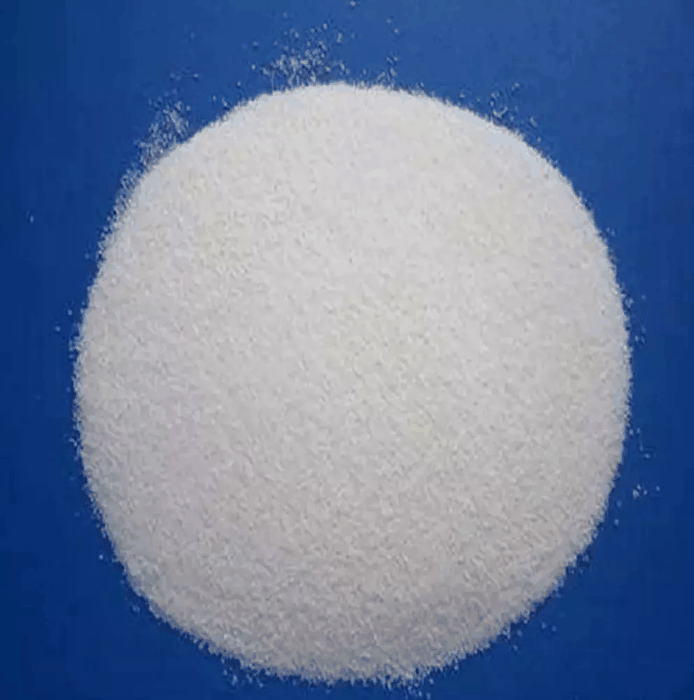 Fingolimod hydrochloride 98%View Details
Fingolimod hydrochloride 98%View Details -
 Fingolimod Hydrochloride CAS 162359-56-0View Details
Fingolimod Hydrochloride CAS 162359-56-0View Details
162359-56-0 -
 Fingolimod Hydrochloride CAS 162359-56-0View Details
Fingolimod Hydrochloride CAS 162359-56-0View Details
162359-56-0